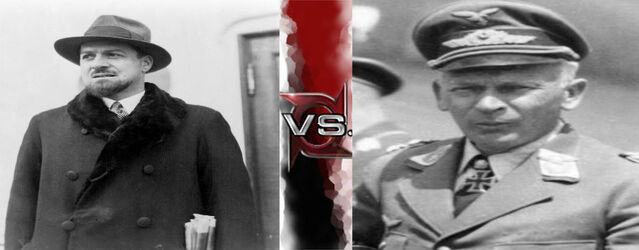Airplanes. The metal creatures that allowed man to imitate the natural actions of the bird. They've been used for many purposes both uplifting and horrifying. They've allowed the world to connect to each other, for the continents to be united in trade and diplomacy. But such a useful utility such as this almost always finds its way to war.
What started from the Wright brothers' first powered flight in the early 20th century evolved into a sundry of much more advanced aircraft that were capable of such power that their pioneers would be unable to understand. From the Dresden bombing, to the destruction of Hiroshima and Nagasaki, to more modern atrocities such
So today, I wish to use two mostly forgotten air commanders, whose battles are untold in the history books.
Italo Balbo, the Italian Governor of Libya who served as the Marshall of the Air force
vs
Wolfram Freiherr von Richthofen, the Generalfeldmarschall who had great success in the Crimean campaigns and the Eastern front!
Wolfram Freiherr von Richthofen[]
Wolfram Freiherr von Richthofen (10 October 1895 – 12 July 1945) was a German field marshal of
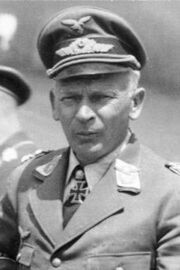
the Luftwaffe(German Air Force) during World War II. Born in 1895 into a family of the Prussian nobility, Richthofen grew up in prosperous surroundings. At the age of eighteen, after leaving school, he opted to join the German Army rather than choose an academic career, and joined the army's cavalry arm in 1913.
On the outbreak of the First World War, Richthofen fought on the Western Front, winning the Iron Cross Second Class. In 1915 he was posted to the Eastern Front, where he stayed until 1917.
After the war Richthofen resumed civilian life after being discharged from the army. He studied engineering at a university before rejoining the Reichswehr, the German armed forces of the Weimar Republic era. In 1933 Hitler and the Nazi Party came to power in Germany, and the Reichswehr was transformed into the Wehrmacht. Richthofen joined the new Luftwaffe. He also served as part of the Condor Legion which supported the Nationalists in the Spanish Civil War.
When the Second World War broke out in September 1939, Richthofen commanded a specialised ground-attack air unit, Fliegerkorps VIII (8th Air Corps), first as a small active service unit in the Polish Campaign, and then as a full-sized Air Corps in Western Europe, from May to June 1940. He was awarded the Knight's Cross of the Iron Crosson 23 May 1940, in view of his achievements. He continued in frontline service during the Battle of Britain and the Balkans Campaign in 1940 and 1941.
Richthofen achieved his greatest success on the Eastern Front. In particular, he achieved notable success in the Crimean Campaigns during 1942. Despite offering vital tactical and operational support to Army Group South, after the victory at the Third Battle of Kharkov he was moved to the Mediterranean Theatre of Operations, where he commanded Luftwaffe forces in the Italian Campaign. He remained in active service until late 1944, when he was retired on medical grounds. Soon after the capitulation of Germany in May 1945, he was taken prisoner by the United States Army, but on 12 July he died in captivity of a brain tumour.
Italo Balbo[]
Italo Balbo (Ferrara, 6 June 1896 – Tobruk, 28 June 1940) was an Italian Blackshirt (Camicie Nere, or CCNN) leader
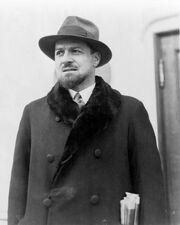
who served as Italy's Marshal of the Air Force (Maresciallo dell'Aria), Governor-General of Libya, Commander-in-Chief of Italian North Africa (Africa Settentrionale Italiana, or ASI), and the "heir apparent" to Italian dictator Benito Mussolini.
After serving in World War I, Balbo became the leading Fascist organizer in his home region of Ferrara. He was one of the four principal architects (Quadrumviri del Fascismo) of the March on Rome that brought Mussolini and the Fascists to power in 1922, along with Michele Bianchi, Emilio De Bono and Cesare Maria De Vecchi. In 1926, he began the task of building the Italian Royal Air Force and took a leading role in popularizing aviation in Italy, and promoting Italian aviation to the world. In 1933, perhaps to relieve tensions surrounding him in Italy, he was given the government of Italian Libya, where he resided for the remainder of his life. Balbo was the only leading Fascist to oppose Mussolini's alliance with Nazi Germany. Early in World War II, he was killed by friendly fire when his plane was shot down over Tobruk by Italian anti-aircraft guns.
Fighters[]
Fiat CR.42 x30 (Balbo)[]
The Fiat CR.42 Falco ("Falcon", plural: Falchi) was a single-seat sesquiplane fighter developed and produced by Italian aircraft manufacturer Fiat Aviazione. It served primarily in Italy's Regia Aeronautica both before and during
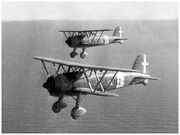
the Second World War.
The CR.42 was an evolutionary design of Fiat’s earlier CR.32 fighter, featuring a more powerful supercharged Fiat A.74R1C.38 air-cooled radial engine and aerodynamic improvements to its relatively clean exterior surfaces. The aircraft proved to be relatively agile in flight, a factor that had been attributed to its very low wing loading and a sometimes decisive tactical advantage. RAF Intelligence praised its exceptional maneuverability, further noting that "the plane was immensely strong",though it was technically outclassed by faster, more heavily armed monoplanes. While primarily used as a fighter, various other roles were adopted for some variants of the type, such as the CR.42N dedicated night fighter model, the CR.42AS ground attack aircraft, and the CR.42B Biposto twin-seat trainer aircraft.
Top Speed: 274 MPH
Armament:
- 2 × 12.7 mm (0.5 in) Breda SAFAT machine guns, 400 rpg.
- 2 × 12.7 mm (.5 in) machine-guns in underwing fairing on some.
Engine: 1 × Fiat A.74 RC38 radial air-cooled, fourteen cylinders radial engine (840 horsepower)
Crew: 1
Range: 780 km (420 nmi, 485 mi)
Messerschmitt Bf 109 x30 (Richthofen)[]
The Messerschmitt Bf 109 is a German World War II fighter aircraft that was the backbone of the Luftwaffe's fighter
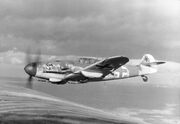
force.The Bf 109 first saw operational service in 1937 during the Spanish Civil War and was still in service at the dawn of the jet age at the end of World War II in 1945. It was one of the most advanced fighters of the era, including such features as all-metal monocoque construction, a closed canopy, and retractable landing gear. It was powered by a liquid-cooled, inverted-V12 aero engine. From the end of 1941, the Bf 109 was steadily being supplemented by the Focke-Wulf Fw 190. It was commonly called the Me 109, most often by Allied aircrew and even among the German aces themselves, even though this was not the official German designation.
Top Speed: 398 MPH
Armament:
- 2 × 13 mm (.51 in) synchronized MG 131 machine guns with 300 rpg
Engine: 1 × Daimler-Benz DB 605A-1 liquid-cooled inverted V12 (1200 horspower)
Crew: 1
Range: 850 km (528 mi)
Bombers[]
Junkers Ju 87 x50 (Richthofen)[]
The Junkers Ju 87 or Stuka (from Sturzkampfflugzeug, "dive bomber") is a German dive bomber and ground-attack
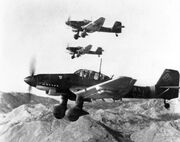
aircraft. Designed by Hermann Pohlmann, it first flew in 1935. The Ju 87 made its combat debut in 1937 with the Luftwaffe's Condor Legion during the Spanish Civil War and served the Axis forces in World War II.
The aircraft was easily recognisable by its inverted gull wings and fixed spatted undercarriage. Upon the leading edges of its faired main gear legs were mounted the Jericho-Trompete (Jericho trumpet) wailing sirens, becoming the propaganda symbol of German air power and the blitzkrieg victories of 1939–1942. The Stuka's design included several innovative features, including automatic pull-up dive brakes under both wings to ensure that the aircraft recovered from its attack dive even if the pilot blacked out from the high g-forces.
Top Speed: 242 MPH
Armament:
- x2 7.62mm MG17 machine guns(front) x2 7.62mm MG15 machine guns (rear)
- 1× 250 kg (550 lb) bomb beneath the fuselage and 4× 50 kg (110 lb), two bombs underneath each wing
Crew: 2(One front and rear)
Engine: 1x Jumo 211J-1 Inverted -V piston ( 1400 horsepower)
Range: 500 km (311 mi)
Savoia-Marchetti SM.79 Sparviero x50 ( Balbo)[]
The Sparviero (Italian for sparrowhawk) was a three-engined Italian medium bomber developed and manufactured by
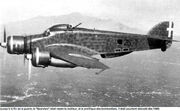
aviation company Savoia-Marchetti. It could be the best-known Italian aeroplane of the Second World War. The SM.79 was easily recognizable due to its distinctive fuselage dorsal "hump", and was reportedly well liked by its crews, who nicknamed it il gobbo maledetto ("damned hunchback").
The SM.79 had been originally developed during the early 1930s as a cantilever low-wing monoplane employing a combined wood-and-metal structure. It had been designed with the initial intention of producing a swift eight-passenger transport aircraft, capable of besting even the fastest of its contemporaries at that time, however, the project quickly attracted the attention of the Italian government for its potential as an armed combat aircraft. Performing its first flight on 28 September 1934; between 1937 and 1939, early examples of the type established 26 separate world records, qualifying it for some time as being the fastest medium bomber in the world. As such, the SM.79 quickly became regarded as an item of national prestige in Fascist Italy, attracting significant government support and often being deployed as an element of state propaganda. Early on, the aircraft was routinely entered into competitive fly-offs and air races, seeking to capitalize on its advantages, and often emerged victorious in such contests.
Top Speed: 286 mph
Armament:
- 1 × 20 mm (0.79 in) forward MG 151 cannon
- 2 × 12.7 mm (0.5 in) dorsal Breda-SAFAT machine gun 1 at the top, 1 in the belly (The belly gun was optional).
- 2 × 7.7 mm (0.303 in) machine guns in lateral "waist-gun" ports (optional)
- 1,200 kg (2,645 lb) internal bomb load
Crew: 6
Engine: x3 Piaggo P.XI air-cooled radial piston engines (1000 horsepower)
Range: 2,600 km (1,615 mi)
Groups[]
Luftwaffe ( 8th Air Corps)[]
The Luftwaffe[was the aerial warfare branch of the combined German Wehrmacht military forces during World War
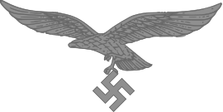
II. Germany's military air arms during World War I, the Luftstreitkräfte of the Army and the Marine-Fliegerabteilung of the Navy, had been disbanded in May 1920 as a result of the terms of the Treaty of Versailles which stated that Germany was forbidden to have any air force.
The Luftwaffe proved instrumental in the German victories across Poland and Western Europe in 1939 and 1940. During the Battle of Britain, however, despite inflicting severe damage to the RAF's infrastructure and, during the subsequent Blitz, devastating many British cities, the German air force failed to batter the beleaguered British into submission. From 1942, Allied bombing campaigns gradually destroyed the Luftwaffe's fighter arm. From late 1942, the Luftwaffe used its surplus ground, support and other personnel to raise Luftwaffe Field Divisions. In addition to its service in the West, the Luftwaffe operated over the Soviet Union, North Africa and Southern Europe. Despite its belated use of advanced turbojet and rocket propelled aircraft for the destruction of Allied bombers, the Luftwaffe was overwhelmed by the Allies' superior numbers and improved tactics, and a lack of trained pilots and aviation fuel. In January 1945, during the closing stages of the Battle of the Bulge, the Luftwaffe made a last-ditch effort to win air superiority, and met with failure. With rapidly dwindling supplies of petroleum, oil, and lubricants after this campaign, and as part of the entire combined Wehrmacht military forces as a whole, the Luftwaffe ceased to be an effective fighting force.
Specifically in this battle, Richthofen will be in command of the 8th Air Corps:
8th Air Corps (VIII. Fliegerkorps) was formed 19 July 1939 in Oppeln as Fliegerführer z.b.V. ("for special purposes"). It was renamed to the 8th Air Corps on 10 November 1939. The Corps was also known as Luftwaffenkommando Schlesien between 25 January 1945 and 2 February 1945 and was merged with Luftgau-Kommando VIII on 28 April 1945 and redesignated Luftwaffenkommando VIII.
Regia Aeronautica[]
The Italian Royal Air Force (Regia Aeronautica Italiana) was the name of the air force of the Kingdom of Italy. It was
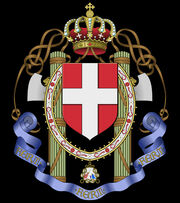
established as a service independent of the Royal Italian Army from 1923 until 1946. In 1946, the monarchy was abolished and the Kingdom of Italy became the Italian Republic, whereupon the name of the air force changed to Aeronautica Militare.
The Italian air force became an independent service—the Regia Aeronautica—on March 28, 1923. Benito Mussolini's fascist regime turned it into an impressive propaganda machine, with its aircraft, featuring the Italian flag colors across the full span of the undersides of the wings, making numerous record-breaking flights.
The first test for the new Italian Royal Air force came in October 1935, with the Ethiopian war. During the final stages of the war, Regia Aeronautica deployed up to 386 aircraft, operating from Eritrea and Somalia. The Italian aviators did not have any opposition in the air, as the Imperial Ethiopian Air Force had just 15 transport and liaison aircraft, only nine of which were serviceable. However the Regia Aeronautica lost 72 planes and 122 aircrew members while supporting the operations of the Regio Esercito, sometimes dropping poison gas bombs against the Ethiopian army. And after the end of hostilities, on 5 May 1936, for the following 13 months the Regia Aeronautica had to assist Italian forces in fighting Ethiopian guerrillas.
During World War II Regia Aeronautica had experience in Albania, France, East/West Africa, Britain, Greece, Yugoslavia, the Eastern Front in Russia, and various other European theaters, often times assisting the Luftwaffe, like in the Western Desert campaign and the later parts of the Eastern Front.
X-factors[]
Experience:
Richthofen: At the age of eighteen, after leaving school, he joined the German Army's cavalry arm in 1913.Richthofen fought on the Western Front, winning the Iron Cross Second Class. In 1915 he was posted to the Eastern Front, where he stayed until 1917. His cousins, the brothers Lothar and Manfred von Richthofen both became flying aces and they encouraged him to join the Luftstreitkräfte where served multiple missions. Richthofen joined the new Luftwaffe when Hitler and the Nazi party took control. He also served as part of the Condor Legion which supported the Nationalists in the Spanish Civil War. in September 1939, Richthofen commanded the Fliegerkorps VIII (8th Air Corps), first as a small active service unit in the Polish Campaign, from May to June 1940. Richthofen achieved great success on the Eastern Front.He fought in the Crimean campaigns through 1942. After this he was moved to the Mediterranean Theatre of Operations, where he commanded Luftwaffe forces in the Italian Campaign. He remained in active service until late 1944, when he was retired on medical grounds.
Balbo:During WW1, Balbo was an officer in the Italian Royal army and had experience in the Alpini Battalion before volunteering for flight training in 1917. Not long after this, the Germans and Austro-Hungarian forces broke through Italian lines, forcing him to return to the front. After the war he became a major Blackshirt organizer, and after that his next major experience was leading transatlantic flights through the 1930's. He secretly organized men to attack Ethiopia during the Abyssinia crisis. During the time of WW2 in 1940, he was planning an invasion of Egypt when on a mission, he was shot down by his own anti-aircraft weaponry.
Training:
Richthofen: Richthofen didn't really get any significant training until 1919 to 1922, where he studied aeronautical engineering at the Technical University of Hanover. Besides his engineering training, he likely would have received standard Luftwaffe training, as he was a major officer.
Balbo/Regia Aeronautica: Balbo lacked any real training until 1926, where he was appointed Secretary of State for Air and was given a crash course on aviation and began building the Italian Royal Air Force. Other than this he received no major training.
Tactics:
Richthofen: Richthofen was a champion of two forms of tactics, shuttle air and dive bombing. In shuttle air, to maximize support over the frontline, aircraft operated from bases near the front to keep and gain an advantage. Aircraft were sent in small formations to bomb frontline positions, while other groups of ground attack aircraft were en route and refuelling. Dive bombing involves a plane fly right at it's target to maximize accuracy.
Balbo/Regia Aeronautica: Since there isn't much information on Balbo's tactical style, so i'll have to take into consideration how Regia Aeronautica approached their battles. For this battle I will take their actions at the Siege of Malta as an example. In the Siege of Malta, Regia Aeronautica began the aerial bombardment of the island from airbases in Sicily. On the first day, 55 Italian bombers and 21 fighters flew over Malta and dropped 142 bombs on the three airfields at Luqa, Hal Far and Ta Qali. In the afternoon, another 38 bombers escorted by 12 fighters raided the capital. The raids were designed to affect the morale of the population rather than inflict damage to dockyards and installations. A total of eight raids were flown on that first day. The bombing did not cause much damage and most of the casualties suffered were civilian. It also seems that Regia Aeronautica relied on assistance from the the Luftwaffe to conduct air missions, or at least they frequently would.
Logistics:
Richthofen: Germany always lacked resources throughout the war, and constantly had to base their strategy. They would frequently have to attack cities just to take their resources. That and intense bombing of their oil that they did have, caused them to lack resources altogether. This made it impossible to maintain the powerful planes that they made.
Balbo: Balbo and Regia and Aeronautica weren't much better off, as the organization lost many, many planes throughout their missions, leaving a limited amount of planes to use in general. Also, many of their planes were simply outdated compared to their contemporaries. Their construction lacked the necessary materials to create advanced planes, while having to maintain the ones they had.
Objectives and Battle Situation/Voting[]
This battle will have 35 fighters and 50 bombers on each side. Germany is in the middle of its oil crisis and is desperate to acquire the critical resource in any way possible. Adolf Hitler has decided that Italy has outlived its usefulness and that they would be a perfect opportunity to kill two bird with one stone. Richthofen, one of Hitler's most trusted Luftwaffe commanders, is sent to Libya to what is thought to be an easy invasion.
However, Hitler being the aggressive dictator he is formally declared war on Mussolini, and Italo Balbo, the governor of the land, had been notified, and ordered to establish whatever defensive they possibly can. Richthofen doesn't know that Balbo is prepared for an invasion, and therefore travels with a light force.
Note: Both sides have their own barracks/airfield that both sides will receive intelligence on as the battle is going on. I.E, bombers will not come into play until intelligence is received
Primary Objective:[]
Richthofen: Take the oilfield, and destroy any planes that get in the way of the invasion.
Balbo: Defend the oilfield, and force a retreat of the attacking German force.
Secondary Objectives:[]
Both: Destroy the other sides' barracks, which have the majority of their armaments and supplies for the engagements
Note: All objectives do not require either commanders to be active or even alive to achieve. Ex: If Balbo is killed in the air, and his men are still able to defend against Richthofen's mini-invasion, the objective is still met.
Note 2: Please call me out if I need to change something in this battle, since I've been working for a long time on this and would hate for it to be screwed over now.
You all know what I need for voting but just in case:
Format 1: Detailed edge based vote with good grammar and that isn't just a couple of words or a sentence.
Format 2: At least a 7 sentence paragraph detailing why you believe a certain warrior will win.
Votes like: "Richthofen winns because Italllo's a fillthy spahgetti muncher" or " Italo wiins becausse Naziis badd" will not count.
X-factors are not required in your vote but are appreciated.
I hold the final say as to whether a vote counts or not, guidelines not withstanding.Voting will end when I am satisfied the the quality and quantity of votes.

